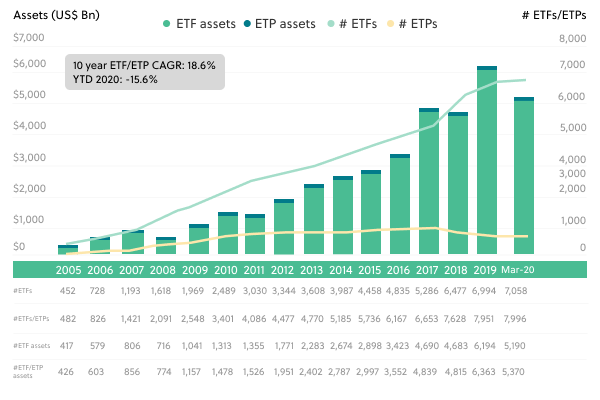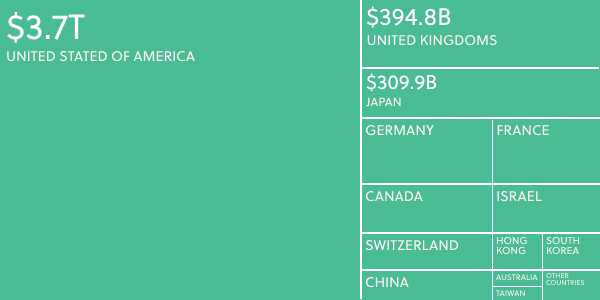Today,
Since the global financial crisis of 2008, the popularity of exchange-traded funds (ETFs) has skyrocketed.
Now, even the world’s most influential central bank — The Federal Reserve — is buying them up. This has added to a global market worth $5.37 trillion, with the majority ($4 trillion) still being managed in the US.
So why invest in ETFS?
In essence, ETFs offer several benefits over traditional open-end funds: The main ones being increased diversification, lower costs, trading flexibility, transparency of holdings, and tax benefits.
To some, this may sound like a mutual fund. But ETFs take traditional mutual funds to the next level. Unlike mutual funds, ETFs offer:
- Trade flexibility. Investors can buy and sell them like shares on exchanges
- Lower expenses from less overhead and operational costs
- Typically more transparency, publishing perspectives of their holdings each day
- Typically less capital gains tax. The tax is only incurred when you sell the ETF.
For others, ETFs may appear like an index fund. Indeed, both types of funds manage a basket of securities — such as stocks, bonds and commodities — that are traded on an exchange.
But ETFs have broken out of this mold by offering a wider inventory of products. These include a growing list of innovative funds that are redefining the world of investment. There are ETFs that now offer (to name a few):
- Niche sector funds, like robotics, fintech, genomic science
and 5G technology - Foreign market funds, including emerging market, developed market and individual country funds
- Leveraged and inverse funds, which intend to multiply or “short” the index or benchmark they follow
- Sustainability funds, which track ESG [environmental, social, and corporate governance] activity [Read more: All You Need to Know About Socially Responsible Investing Portfolios]
- Factor-based funds, which track a basket of securities based on a number of factors, such as high-dividend yields
This vast ecosystem of new funds enables intrinsic portfolio diversification and, thus, better risk management.
Ask anyone from Main Street to Wall Street today, and they’ll quickly answer the question “why invest in ETFs” by reciting the above points.
Yet, understanding the full story requires a look back in time. Let’s examine the rise of ETFs, their current importance and where they are heading next.
Why invest in ETFs: An opportunity born of crisis
In 2008, a great recession was created by a financial crisis. It brought one of the oldest and largest investment banks to its knees.
Lehman Brothers, a bank with a history of over 150 years, collapsed after the US government decided not to bail it out. This caused trillions of dollars to be wiped off the markets, and investors reeled.
This financial shock left a lasting impression that changed the mindset of how people wanted to invest.
More investors began to question the actively managed portfolios that Wall Street investment banks like Lehman Brothers offered. They charged high fees but failed to outperform low-cost index funds.
Over the next decade, investors began to ditch the costly financial advisors that ran actively managed portfolios. They went with a novel form of index fund, called an exchange-traded fund. Instead of employing a team of financiers to actively “beat the market,” the majority of ETFs offered investors the ability to passively track indexes or benchmarks; a considerably appealing benefit for risk-concerned investors in the wake of a financial crisis.
The growth in ETFs since the financial crash has been astounding. In 2008, the global ETF industry was worth $774 billion. By 2019, it would be worth $6.36 trillion. (see chart below)
The massive growth of passive investing
But the ETF was already a well known part of the investment acronym soup by the time Lehman Brothers fell. The first ETF made its debut on January 22, 1993 when it was released by State Street Global Investors.
Launching with just $6.5 million in assets, the SPDR S&P 500 ETF quickly rose to become the poster child of the post-crisis ETF boom. By 2013, it was the world’s largest ETF. With more than $123 billion in assets under management, it averaged daily trading volume of 144 million shares.
Today, while there are very few actively managed ETFs, investors relly more and more on passively managing ETFs. Backed by data, the passive investment strategy is gaining more popularity.
In the 1970s, Vanguard created the first passively managed index fund. The investment group today, along with BlackRock and State Street, makes up the “Big Three” giant passive investment managers in the US.
At the time, the concept was groundbreaking, albeit simple.
Instead of hiring a fund manager to actively pick stocks to maximize returns, the fund would simply replicate fund indices. This gave room for slashing overhead costs. These same principles hold true for ETFs and have played a large role in their soaring popularity.
The new go-to investment fund
After 2008, a new trend became clear. The appetite for passively managed funds grew phenomenally. ETF companies were starting to offer in great variety and number. ETFs have now become the go-to investment instrument for investors looking to get stable returns over the long haul.
Today, ETFs can account for about a quarter of the daily volume in the U.S. stock markets. The volume can jump up to as much as 40 percent on some days, according to Bloomberg. Indeed, the U.S. is a leader in the industry, holding about 70% of global ETF assets. (see chart below)
Note: As of September 7, 2018
In early 2020, the latest supporter to emerge for ETFs was none other than the world’s most influential central bank.
A historic decision
During the coronavirus outbreak, the U.S. Federal Reserve made a historic decision — they would buy hield-yield and investment-grade bonds via ETFs. With bond markets seeing high volatility during the pandemic, the Fed put its confidence in ETFs which saw much lower daily bid-ask spreads. It pumped billions into listings such as BlackRock’s iShares iBoxx USD Investment Grade Corporate Bond ETF (NYSEARCA: LQD). It still left room so as not to crowd out investors.
“The Federal Reserve’s efforts to provide liquidity to the credit markets has included purchasing ETFs, but the government’s purchase of less than $2 billion leaves a lot for traditional investors,” said CFRA Director of ETF & Mutual Fund Research Todd Rosenbluth in a recent note.
The same Bloomberg report also highlights that even traditional investors are now showing greater interest in ETFs. “Pension plans and insurers are increasingly using these funds as the low-cost core of their portfolios,” says Bloomberg.
Indeed, since the pandemic began, a surge of investment from this group has also been noticed by BlackRock.
“If you look at iShares net inflows in April, we had $18 billion in fixed-income ETFs. Nearly half came from first-time buyers of bond ETFs that historically were skeptical of how bond ETFs would perform under market stress,” says Salim Ramji, global head of iShares and index investments and a member of parent BlackRock’s global executive committee.
Low-Overhead, Lower-Cost
A popular ETF offering, iShares has experienced serious growth. This is also due to the low pricing that comes with lower operational costs – among other reasons. “The iShares have grown because we’re providing transparency, convenience, and often a much, much lower-cost service,” Ramji comments.
These much lower-cost services remain a clear draw of ETFs for the widest range of investors.
Unlike actively managed indices, companies like BlackRock that offer ETFs do not need to incur astronomical costs. They save on hiring financial advisors, analysts, and call centers to handle questions from thousands of clients.
Yet, while these cost reductions have helped to instigate rising appeal for ETFs, it will ultimately be the industry’s ability to innovate that will place ETFs on top of mind. When it comes to creating portfolios with greater diversification, investment managers will want to see diversity.
Diversifying With ETFs: A Key to the Modern Portfolio Theory
Today, most financial experts agree that the pros of ETFs overshadow the cons by a large margin.
Indeed, one of ETFs pluses is also one of its few minuses. The great range of ETFs out there and the holdings they represent make the industry complex. Within that complexity, a proper diversification offers growth opportunity like no other.
By 2019, there were over 6,970 ETFs being traded globally, offering tradeable market securities of increasing depth and range.
Nowadays, the development of new ETFs has become a strong barometer of the global investment zeitgeist.
For instance, BlackRock announced in January that it would begin increasing its release of ESG [environmental, social, and corporate governance] ETFs. Great news for those looking to invest in their values!
“We’ve raised $17 billion in our ESG lines; we’re now at 105 ESG ETFs and index funds globally. We expect to be at 120 funds before the end of the year and 150 products over the next year or so,” says Ramji.
This ever-brightening constellation of new ETFs is a gift to investment managers that follow the Modern Portfolio Theory (MPT). MPT hinges on the ability to diversify investments.
Introduced in a 1952 essay by American economist Harry Markowitz, the theory offers a mathematical framework that aims to maximize expected returns for a given set of risks.
The paper earned Markowitz a Nobel Prize in Economics. It provided investors with a tool to better manage asset risk and predict probable returns through diversification.
These principles are what have helped make Sarwa the number 1 hybrid Robo-advisor in the UAE. It formed the basis of why we invest in ETFs and how we choose them. ETFs are now an integral part of an investment strategy that we are proud to stand by.
Takeaways
Why invest in ETFs? They are a popular way to diversify. ETFs have now become the go-to investment instrument for investors looking to get stable returns over the long haul. This type of fund achieves this by creating innovative diversified portfolios when applying the right methodology.
Why invest in ETFs? They are not mutual funds nor index funds. ETFs have become popular because they are more flexible and transparent than mutual funds. More innovative than index funds, they offer the ability to invest
Why invest in ETFs? Serious growth of ETFs started in 2008 — After the 2008 financial crisis, smart investors began to turn to ETFs. Today there are over 6,970 ETFs being traded globally. Based on MPT, you can build a portfolio of “complementary” assets with a low correlation to each other. Data shows that choosing the right mix of ETFs based on proper diversification is the winning strategy.
Sarwa is your online financial advisor. We help you put your money to work in international markets so you can reach your life goals. We launched a series of articles to give you some tips on smart investing.


